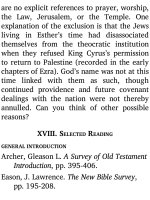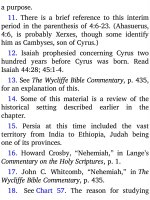Jensens survey of the old testament adam 265
Bạn đang xem bản rút gọn của tài liệu. Xem và tải ngay bản đầy đủ của tài liệu tại đây (153.35 KB, 4 trang )
18. J. Sidlow Baxter, Explore the Book, 4: 208.
19. Read these verses where the same Hebrew
word (translated “embrace”) appears: 2 Kings
4:16; Job 24:8(KJV); Ecclesiastes 3:5; Song of
Solomon 2:6.
20. Quoted in Frank E. Gaebelein, Four Minor
Prophets, p. 142.
21. Cf. 1 Chronicles 25:1. If this is so, his
home was in Jerusalem.
22. Compare this reading with the paraphrase
of The Living Bible.
23. Merrill F. Unger, Unger’s Bible Handbook,
p. 425. “Theophany” is an appearance or
manifestation of God to man.
28
The Postexilic Prophets
(Haggai, Zechariah, Malachi)
Haggai, Zechariah, and Malachi were the
last writing prophets to minister to Israel in
Old Testament times. They are called
postexilic prophets because they served after
the Jews had returned to Canaan from exile
in Babylon. See Chart 96. Who were the
preexilic prophets, and who were the exilic
prophets? Do you see why the postexilic
prophets are also called the restoration
prophets?
These rst pages of the chapter are
devoted to a study of the historical setting
of Haggai, Zechariah, and Malachi. The
Bible text of the three books will come alive
to you if, among, other things, you have
seen what situations moved God to
commission the three prophets to write.1
The historical books which have the same
setting as the postexilic prophets are Ezra,
Nehemiah, and Esther. Therefore, it will be
helpful to review the backgrounds of those
books, studied in chapter 15. Most of that
material is not repeated in this chapter.
I. TWO KINGDOMS AND TWO CAPTIVITIES
Before you begin your study of the
postexilic prophets, review the historical
setting before restoration. Recall that when
we speak of “restoration” we are referring to
the conditions accompanying the return of
God’s people to Canaan from captivity. The
captivity itself took place in two stages,
known as the Assyrian and Babylonian
captivities. Refer back to chapter 15 and
study again the descriptions of these two
captivities. Israel, the Northern Kingdom,
was taken captive by the Assyrians in 722
B.C. Judah, the Southern Kingdom, was
conquered by the Babylonians, one hundred
twenty-six years later, in 586 B.C.
II. DURATION OF THE BABYLONIAN CAPTIVITY
The exile began with Nebuchadnezzar’s
rst invasion of Judah in 605 B.C. (2 Chron
36:2-7), and ended with the rst return of
the Jews to Canaan in 536 B.C.2 (Ezra 1). See
Chart 57.3
III. CONTEMPORARY RULERS
Review this subject as it is discussed in
chapter 15. Identify these names on Chart
57, and relate them to the times of the
postexilic prophets: Cyrus, Darius, and
Artaxerxes. The name Darius appears three









